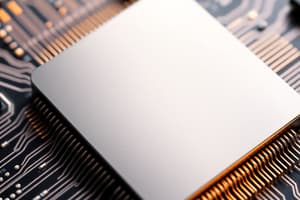Podcast
Questions and Answers
What is the primary function of the Arithmetic Logic Unit (ALU) in a computer system?
What is the primary function of the Arithmetic Logic Unit (ALU) in a computer system?
The ALU completes arithmetic and logical operations.
How does the Control Unit (CU) manage the flow of instructions within the CPU?
How does the Control Unit (CU) manage the flow of instructions within the CPU?
The Control Unit controls operations of the CPU by managing data flow and decoding instructions.
What role do registers play in a computer's processing capabilities?
What role do registers play in a computer's processing capabilities?
Registers temporarily store data and operate at very high speeds.
What information does the Program Counter (PC) hold in a CPU?
What information does the Program Counter (PC) hold in a CPU?
Describe the purpose of the Memory Address Register (MAR) in the CPU.
Describe the purpose of the Memory Address Register (MAR) in the CPU.
What is the function of the Memory Data Register (MDR)?
What is the function of the Memory Data Register (MDR)?
What does the Current Instruction Register (CIR) store?
What does the Current Instruction Register (CIR) store?
Explain the function of buses within the CPU.
Explain the function of buses within the CPU.
What is the primary function of the address bus in a computer system?
What is the primary function of the address bus in a computer system?
Describe the purpose of the control bus in a computer's architecture.
Describe the purpose of the control bus in a computer's architecture.
How is assembly code divided for execution?
How is assembly code divided for execution?
What does the Fetch phase in the FDE cycle involve?
What does the Fetch phase in the FDE cycle involve?
What factors affect CPU performance?
What factors affect CPU performance?
What is the key advantage of Harvard architecture?
What is the key advantage of Harvard architecture?
What is the benefit of using Von Neumann architecture?
What is the benefit of using Von Neumann architecture?
What is contemporary processing in relation to computer architecture?
What is contemporary processing in relation to computer architecture?
Flashcards
ALU (Arithmetic Logic Unit)
ALU (Arithmetic Logic Unit)
The part of the CPU that performs arithmetic and logical operations like addition, subtraction, and comparisons.
Control Unit
Control Unit
The part of the CPU responsible for controlling the operations of the CPU, including fetching instructions, decoding instructions, and coordinating data flow between the CPU and other components.
Registers
Registers
Small, high-speed memory locations within the CPU that temporarily store data and instructions for quick access.
Program Counter (PC)
Program Counter (PC)
Signup and view all the flashcards
Accumulator (ACC)
Accumulator (ACC)
Signup and view all the flashcards
Memory Address Register (MAR)
Memory Address Register (MAR)
Signup and view all the flashcards
Memory Data Register (MDR)
Memory Data Register (MDR)
Signup and view all the flashcards
Current Instruction Register (CIR)
Current Instruction Register (CIR)
Signup and view all the flashcards
Address Bus
Address Bus
Signup and view all the flashcards
Control Bus
Control Bus
Signup and view all the flashcards
Opcode
Opcode
Signup and view all the flashcards
Operand
Operand
Signup and view all the flashcards
FDE Cycle
FDE Cycle
Signup and view all the flashcards
Harvard Architecture
Harvard Architecture
Signup and view all the flashcards
Von Neumann Architecture
Von Neumann Architecture
Signup and view all the flashcards
Contemporary Processing
Contemporary Processing
Signup and view all the flashcards
Study Notes
Processor Structure and Function
- The Arithmetic Logic Unit (ALU) performs arithmetic and logical operations.
- The Control Unit manages CPU operations, including data flow between the CPU and other devices, and instruction decoding.
- Registers are small, high-speed memory cells that temporarily store data.
- The Program Counter (PC) holds the address of the next instruction.
- The Accumulator (ACC) stores calculation results.
- The Memory Address Register (MAR) stores the memory address for reading or writing.
- The Memory Data Register (MDR) temporarily stores data read or to be written.
- The Current Instruction Register (CIR) holds the current instruction, divided into opcode and operand.
- Buses are sets of parallel wires connecting CPU components.
- Data Bus: Bi-directional, transfers data and instructions.
- Address Bus: Used to specify memory addresses.
- Control Bus: Sends control signals between internal and external components.
- Opcode and Operand are components of an instruction.
- Opcode: The type of instruction.
- Operand: The data for the operation.
- The fetch-decode-execute (FDE) cycle is the basic operation of the CPU.
- Fetch: The CPU retrieves an instruction from memory.
- Decode: The CPU interprets the instruction.
- Execute: The CPU performs the instruction's operation.
- Factors affecting CPU performance: Clock speed, number of cores, cache memory size.
- Types of Computer Architectures
- Harvard Architecture: Separates data and instruction memory
- Von Neumann Architecture: Combines data and instruction memory
Studying That Suits You
Use AI to generate personalized quizzes and flashcards to suit your learning preferences.




